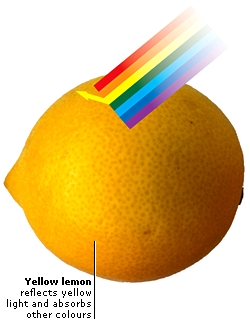DK Science: Colour
On a sunny day, the world seems light and colourful because our eyes are able to see differences in the wavelengths of light as different colours. Some animals cannot do this and live in a colourless world. Sunlight looks white or yellow to us, but is really a mixture of light of many different colours. Coloured light is one of the things that makes objects look different from one another. A tomato looks red because it reflects red light into our eyes, while an apple looks green because it reflects green light.
The colours of a rainbow are made when sunlight shines through raindrops. When a ray of sunlight enters a raindrop, the tiny drop of water splits up the white light into different colours. Although a rainbow usually looks semicircular from the ground, it appears as a complete circle if you look at it from an aeroplane.
When white light shines into a solid triangle of glass, called a prism, the glass in the prism refracts or changes the direction of the light as it passes through. Different colours of light are made by light of different wavelengths. The prism bends the shorter, blue wavelengths of light more than the longer, red wavelengths. This is how the prism splits white light into its spectrum of colours.
The whole sky can look red at dawn or dusk when the Sun sits low on the horizon. At these times of day, sunlight reaches your area of Earth only after travelling through a thick layer of the atmosphere. Particles in the atmosphere scatter the blue part of sunlight away from Earth. The sunlight and sky seem to turn red because they are missing this blue light.
White light is made of an infinite number of different colours, from violet at one end through to red at the other. This band of visible colours is known as the spectrum. Light at the blue end has a shorter wavelength and higher frequency than light at the red end. Most people can see only seven distinct colours in the spectrum: red, orange, yellow, green, blue, indigo, and violet.

Just as a prism can split white light into different colours, so lights of different colour can be added together to make white light. If three torches shine red, blue, and green light together, the colours combine to make white light. Yellow light appears where the red and green lights overlap. Magenta occurs where the red and blue lights meet. Cyan appears where the blue light meets the green.
Objects look coloured because they reflect or absorb the different colours in white light. A golf ball looks white because it reflects all the wavelengths of light that fall on it. A lemon absorbs all wavelengths of light except yellow, which it reflects into our eyes. A black helmet absorbs all wavelengths of light and reflects none, and so it looks dark to us.

Coloured inks and paints (sometimes called pigments) mix in a completely different way to coloured lights. Each pigment reflects light of a different colour. When two coloured pigments are mixed together, the number of colours they can reflect is reduced. When three pigments are mixed, the mixture does not reflect any colours and appears a brownish black.

